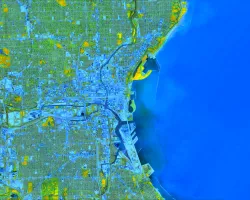
Massachusetts’ agriculture business—which produces some $500 million in products annually—is a large endeavor that relies on a small but mighty partner: The Western Honeybee. Also known as Apis mellifera, this bee is a honey-producing powerhouse. A typical hive can contain anywhere from 20,000-50,000 honeybees that pollinate countless crops. But recently, Western Honeybee populations have plummeted.
For more than the past decade, concern has grown regarding the state of honeybees. Commercial beekeepers throughout the country have seen significant worker population losses in their colonies. In response, NASA DEVELOP partnered with the Best Bees Company and the Dennis vanEngelsdorp Honeybee Epidemiology Lab at the University of Maryland to create a tool called HIVE-OS that incorporates citizen science and NASA Earth observations to help users make decisions based on the environmental variables that lead to honeybee prosperity. DEVELOP is a NASA Earth Science Applied Sciences’ program that addresses environmental and other Earth science issues through strategic partnerships.
DEVELOP used Google Earth Engine to build HIVE-OS. The team incorporated data from NASA Earth-observing satellites that map terrain and measure soil moisture, and U.S. Department of Agriculture (USDA) reports on land cover. HIVE-OS gives users a convenient way to investigate possible correlations of in-hive data with NASA Earth observations. Incorporating Earth observations helps honeybee researchers understand the role local environmental conditions—such as precipitation, soil moisture, and vegetative abundance—play in the complex knot of factors linked to bee health. Another key feature of the HIVE-OS tool is feedback from concerned citizens. Bee enthusiasts and hive owners share local hive conditions—such as location, weight, temperature, and humidity—gathered via in-hive sensors.
HIVE-OS’s marriage of environmental data, Earth-observing imagery, and citizen science is helping discern the variables that affect honeybee health—a critical need for better understanding and reducing the honeybee’s decline. And that insight will also help the future of agriculture in New England—and the rest of the U.S., for that matter.
To read the full Massachusetts feature and other articles about Earth observation applications for each state, visit: https://www.nasa.gov/SpaceforUS/.


